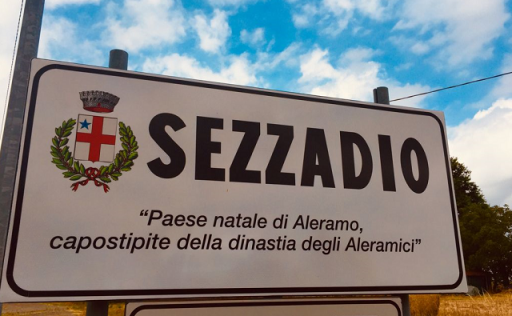(In the photo: The entrance to the city of Sezzadio with the new signs wanted by the Municipal Administration and the nascent Euro-Mediterranean Federation on Ancient Medieval Migration.)
Men and women of culture, united by the idea of the Euro-Mediterranean Federation on Ancient Medieval Migration, challenge this difficult period of the pandemic with new historical research activities to rediscover and transmit the desire to return to normality.
As part of the project of “Le Vie Aleramiche Normanno Sveve” in Sezzadio, a village near Alessandria where Aleramo was born had been visited on the initiative of the Mayor, Enzo Daniele, the Councilor for Culture Piercarla Bocchio, and the local head of FAI Anna Maria Gobello, collected the texts to create an “Aleramici Library” which will be closely linked to the “Aleramici Research Center of Sezzadio“. Two honorary presidents are members of our technical-scientific committee: Francesco Barone of the University of Catania, one of the leading experts in the Aleramici history of Sicily and Salvatore Lo Re, historian and President of the National History Society of Piazza Armerina, City of foundation aleramica which, soon, will see the Municipal Library enriched with a section dedicated to the study of its origins. Therefore, a study workshop will be commenced to work in synergy with the parallel Sicilian structure: the prestigious Palermo “Officina Studi Medievali” headed by Prof. Diego Ciccarelli.
Sezzadio, the place of origin of this fascinating story: it is said, in fact, that the noble Aleprando, on a pilgrimage to Rome, stopped in this small town near Acqui Terme with his wife about to give birth and that Aleramo was born here. The municipal administration of Sezzadio, after having already undertaken various projects to enhance the small center of Alessandria and installed explanatory signs at the entrance to the village to highlight its extraordinary historical importance, has enthusiastically joined the proposal of the promoters of the project, Fabrizio Di Salvo and the UNESCO Club of Piazza Armerina, (represented by the President Anna Maria Di Rosa Placa and the Secretary Lavinia Garsia) and took the opportunity to give life to a research center that will be formed in-network with the Workshop of Medieval Studies in Palermo and the research activity in Piazza Armerina, a real study center dedicated to ancient medieval immigration “on the contrary”.
The fundamental activity was Fabrizio Di Salvo’s visit to Sezzadio last summer which allowed to define the membership of the Municipality of Sezzadio to the Euro-Mediterranean Federation on Ancient Medieval Migrations, by virtue of which it benefits from the support of the Coordinator for Northern Italy, Nadia Ghizzi.
The work of identifying the texts and training the library was supported by our technical-scientific committee which boasts among its ranks the Byzantinist Walter Haberstumpf, Prof. Salvatore Trovato, former professor of Linguistics and Glottology at the Department of Humanities of the University of Catania, the Director of Sibrium Magazine and President of the Center for Prehistoric and Archaeological Studies of Varese Lucilla Caramella, Luigi Piano, the President of “Italia Medievale”, Maurizio Calì, (who collaborated directly in the creation of the library), as well as the teachers and researchers of prestigious international universities, such as the distinguished medievalist Henri Bresc and Joanna Drell of the University of Richmond in the USA.
To realize the intent of making culture available to all, it is essential to give our research a European breath and make people understand how much the history of the Middle Ages, which took place in a Europe different from the current one, was well-defined in its supranational scope. The project connected France, Italy, and Germany and, in particular, the Municipalities of Hauteville-La-Guichard in France, (where the myth has it that Tancredi, the future lord of Hauteville and progenitor of the Altavilla family, saves the life of Duke Riccardo II of Normandy on a hunting trip); of Göppingen, in Baden-Württemberg near Stuttgart, (where tradition has it that the Swabian dynasty was born) and of Piazza Armerina, a city in Sicily founded by Aleramici in the 12th century. The cultural triangulation will also expand in Sezzadio, in the spirit of continuing to create links between historically similar realities and, currently, it takes the form of collaboration between the municipal administrations, anticipating and preparing the future twinning.
Thanks to the dedication of those who embraced and developed the project from the beginning, today, the Euro Mediterranean Federation for Ancient Medieval Migrations stands out for the adhesion of important figures from the world of culture, of high-level institutions, such as the Library of Alexandria of Egypt, of numerous Italian Municipalities, of Universities and Associations. Despite the interruptions due to the pandemic, the Project has given rise to numerous initiatives such as conferences, lectures, and meetings, and the production of a documentary film shot in the European lands touched by this research: Piedmont, Sicily, France, Turkey, Germany, Greece, and Ukraine.
A powerful work, curated for four years by Fabrizio Di Salvo, which collects precious contributions from excellent scholars and returns the atmosphere of medieval Europe thanks to the choice of splendid locations, such as the Castle of Pomaro in Monferrato, to the costumes of the ancient Samantha Panza’s “Principessa Valentina” tailoring from Asti-Italy and coordinated by Gianni Gallo. The exceptional protagonist is the actor Walter Siccardi, an extraordinary interpreter in the role of Aleramo. The shields that recall the emblems of the Aleramici dynasties and parts of the sets used for the shooting will be donated by the Euro-Mediterranean Federation to the Aleramici Research Center in Sezzadio.
We will continue our incessant work of research and historical reconstruction, hoping that it will create opportunities for recovery, resilience, and increasingly nourish the dialogue between people who are only apparently distant.

